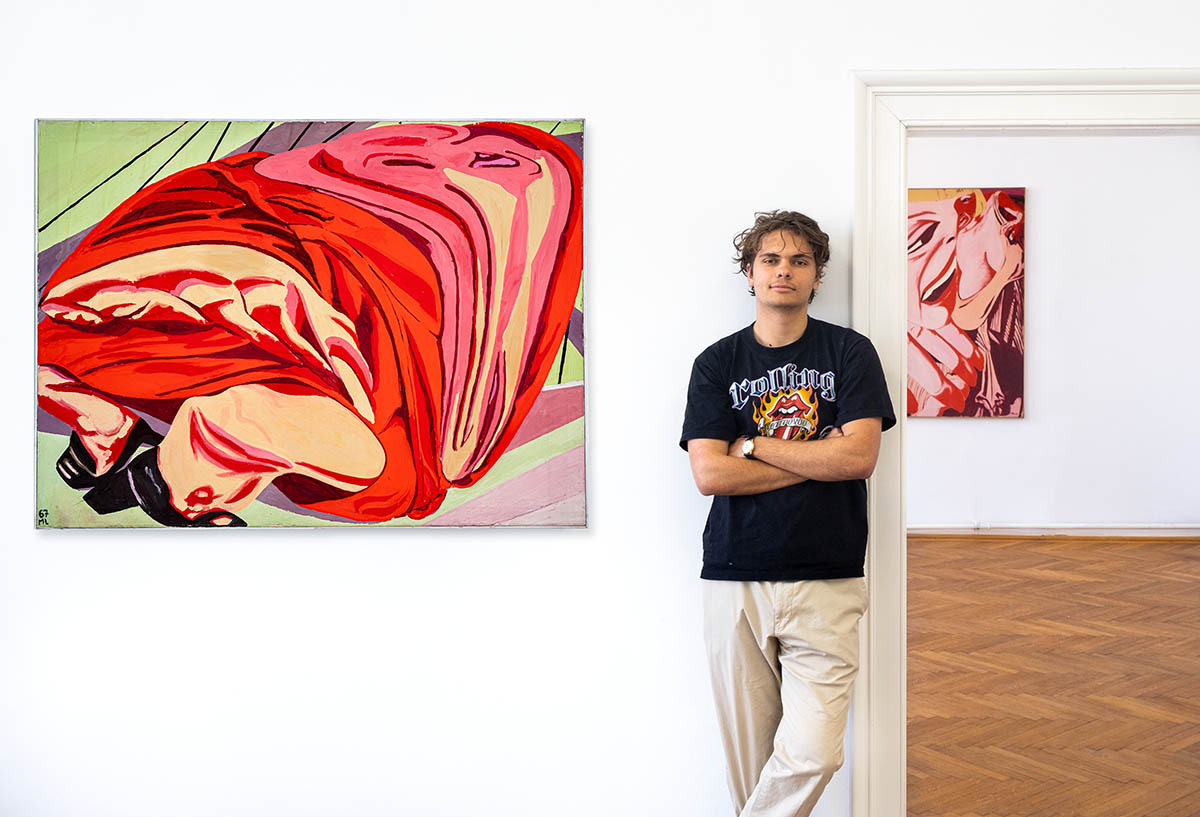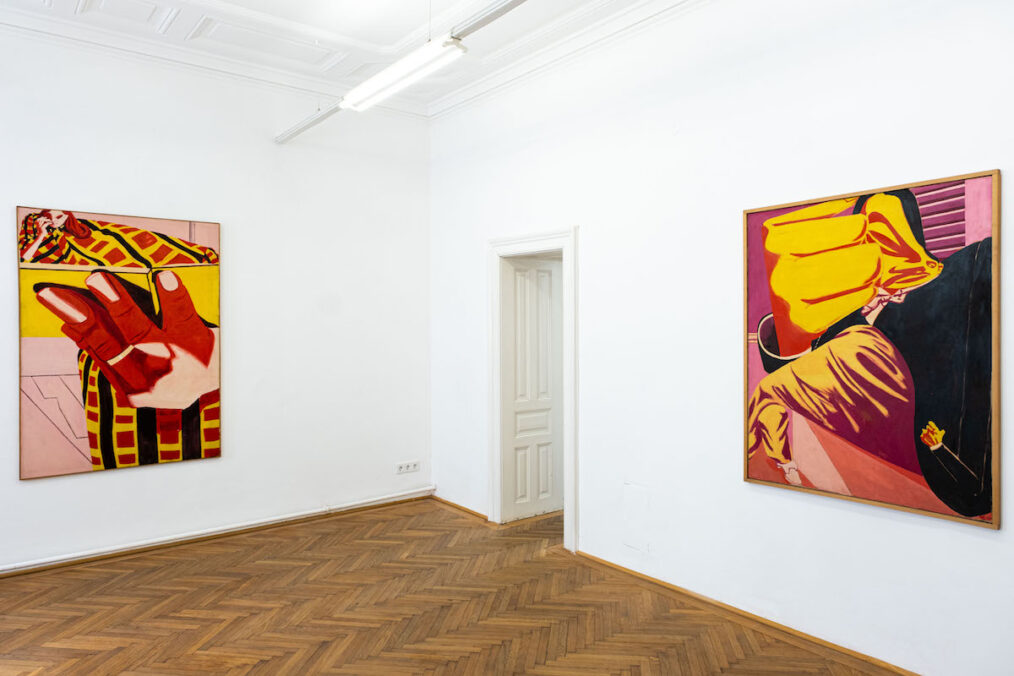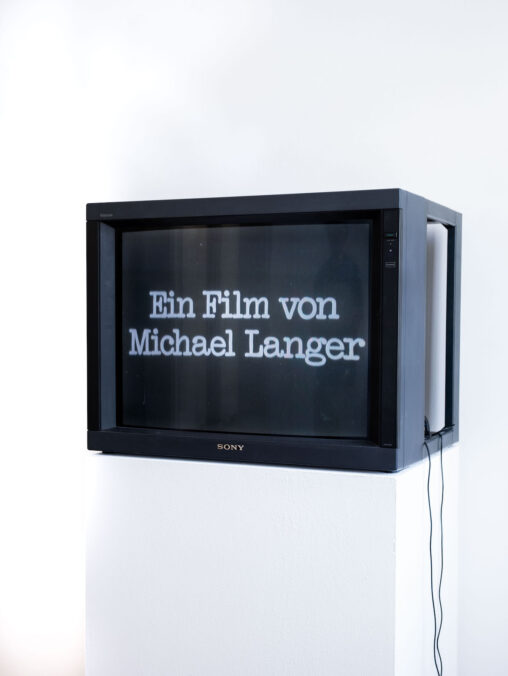
Erka Shalari: Could you share some insights about your journey? Approximately a year ago, you relocated to Vienna for your studies. How has your experience been so far, and what does being in Vienna mean to you?
Hector Hollein: I grew up in Frankfurt, later moved to SF when I was 13 and then moved again to New York when I was 15. I always wanted to come back to Europe and I feel very connected to Vienna even after only one and a half years. Of course, I also miss my friends and family very much, but at the same time, Vienna gave me a lot of freedom to explore my interests and pursue life independently. It may not always be as fast-paced here, but you get a bit more time to breathe, and I’ve grown to like that.

Michael Langer, Absurder Realismus, Exhibition View at Suite 17
ESH: Could you provide some information about the name of the exhibition? Additionally, I’m curious to know about your initial encounter with the artists‘ work.
HH: Michael Langer gave the term “Absurder Realismus” to his own work, which I thought fit pretty well and had a nice sound to it. I had the great privilege to grow up with Michael Langers work. I would be lying if I said that I was fascinated with all his work by the age of 4, but I definitely developed an interest very early. One of the works displayed a very oversized and distorted fist, which stuck with me. I still find out new things about his works, and I never get bored looking at his paintings. Michael Langers work holds a very special place in my life.
ESH: How do the works in the exhibition connect with each other? Would you give us an imaginary tour of the spaces? How are for example the works positioned?
HH: I tried to position the works by feel. Fortunately, I think the works all go very well to each other. When you take a couple steps into the gallery and take a look to the left, you see what I feel to be the main room with the two works “Sitzender” and “Lesende”. Color and subject played a big role in how I chose to place the paintings. These two works focus on hands in their distorted state and have some similarity in their popping colors. In one of the following rooms, “der rote Rock” and “Untitled (woman in yellow skirt) are shown. The bodies in both paintings have a very smooth, almost liquidizing appearance, and I think they go very well together. What I think was most important though was to give some space to these works. The colors and subject can be very “in your face” and maybe a bit overwhelming, so leaving some white walls gave necessary room to breathe.
ESH: What do the „Zerrbilder“ series mean to you?
HH: In my opinion the Zerrbilder Series is Michael Langers strongest work and still remains relevant today. The paintings from 1966-1967 balance very finely between figuration and abstraction. Influences like pop, film or comic are all present, yet the new human figure is always in the forefront of the viewer’s experience. I had to disappoint a lot of people who actually thought that I painted the works myself (I wish).

Michael Langer, Absurder Realismus, Exhibition View at Suite 17
ESH: In one of the exhibition spaces, we see experimental films by the artist. How did Langer transition from painting to film?
HH: Primarily, I think supporting a family as an artist was quite tough. The late 60s were also a time full of political unrest and instability not just in Munich, but the entire world. Michael Langer and a lot of other painters came to a point where they thought that painting as a medium was no longer in a place where it could give an answer or perspective to the issues of the presence.
Langer was looking for a human figure which could represent the absurdity of the real world, I think part of this is also what he means by “I am looking for the absurd in itself”. His figures were already balancing on the line between figuration and abstraction, and he couldn’t distort the body or brighten the color even further.
He didn’t want to return to abstraction. Painting in that sense just wasn’t satisfactory for his vision anymore.
ESH: How does it feel the curatorial work for you? Can you envision yourself pursuing this work indefinitely?
HH: This was my first experience in curation, and I had so much fun putting this exhibition together in the last half year. I 100% want to curate shows more often, but with a greater focus on supporting and giving a platform to younger artists. As long as I have a good time and the opportunity to curate and fascinate people about works that I am passionate about, I’d love to continue my curatorial work.
ESH: Which artists do you consider to be extremely important to you?
HH: There are so so many. If I have to single out an artist, I’d say either Mark Rothko or Clyfford Stil. Both had a huge impact on me and were the first artists which sparked a true fascination with painting. They kind opened my eyes during a time when I wasn’t always happy about being brought along to museums by my parents, which looking back played a great role in bringing me to curating my first show.
Whenever I’m in NY, I spend a couple of hours looking at their work in the MoMA. The work of Diane Arbus is also very special to me. I got to spend a lot of time looking at her photographs while interning at David Zwirner last year and became a huge fan of her work. I’ve also become a fan of artists like Mario Ayala or Woody de Othello. Getting to see their work was a highlight last summer!
ESH: And which are some of your favourite galleries, museum, spaces?
HH: Of course, I have to be a fan of the Met:) New York’s Museums are great, no question. The gallery scene is always really exciting. Spaces like Karma Gallery, Jeffrey Deitch or David Zwirner on 20th Street are some of my favorites. New York also has smaller gems like the earth room by Walter de Maria which is amazing. I’ve grown really fond of the many Museums Vienna has to offer and try my best to see all the exhibitions. I really enjoyed Francesco Clemente at the Albertina last year. Going to a museum by myself is something I try to do as much as possible.
Exhibition: Michael Langer: Absurder Realismus
Exhibition duration: 12.05. – 11.06.2023
At: Suite 17, Franz-Josefs-Kai 3/17
1010 Wien
Erka Shalari (*1988, Tirana, Albania) is a Vienna-based art author. Editor at Les Nouveaux Riches Magazine since 2020. https://linktr.ee/erkashalari





